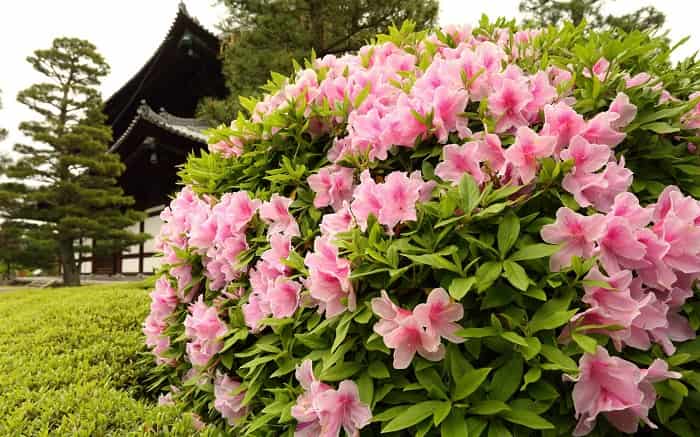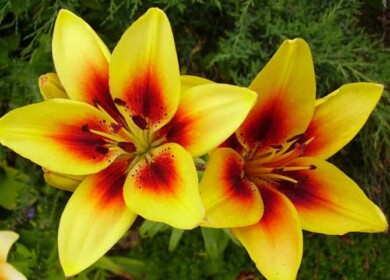How to grow and care for rhododendron before and after flowering

Contents:
- In what cases is additional fertilization required
- Caring for rhododendrons after flowering
- Basic rules for fertilization
- Types of fertilizers for rhododendrons
- Fertilizer application scheme
- Popular fertilizers
- What happens if you stop fertilizing rhododendrons
Rhododendron (another name for this plant is azalea) is a gorgeous evergreen shrub that can look attractive both during flowering and without flowers. It is loved for its dense dark green foliage with an unusual texture and delightful flowering. In this article, we will share some tips on growing, caring for, and fertilizing rhododendrons so that they grow fast and do not get sick.
In what cases is additional fertilization required
The standard scheme for fertilizing rhododendrons: 1 time per year with prolonged-action formulations and 2 times per year with targeted preparations. If the plant is well-groomed and healthy, this scheme is optimal. But if the leaves are pale, there are fewer buds and flowers than usual, then there is not enough nutrition. In this case, it is advisable to conduct a soil analysis to identify a deficiency of microelements and measure the acidity level. Another option is to evaluate the appearance of the plant and, based on visible signs, determine the cause of the problem, and then apply a suitable preparation.
Caring for rhododendrons after flowering

When choosing the best fertilizer for rhododendron after flowering, you can use ready-made fertilizers that differ in purpose. Here are some popular compositions:
- “Epin” is a spraying agent, an effective anti—stress drug.
- “Zircon” — will help the plant adapt after transplanting in the garden.
- “Ecogel-antistress” — a liquid composition that strengthens the plant.
- “Emerald” — helps when the leaves are pale and brown.
- “Ferovit” — for the prevention of chlorosis.
- “Fitosporin-M” — increases immunity to diseases, prevents root rot.
Basic rules for fertilization
It is important to know not only how to fertilize rhododendron at a certain stage of vegetation, but also how to do it correctly. Basic rules of care:
- young plantings should be fertilized only with liquid compounds;
- do not use chlorine-containing, lime fertilizers for rhododendron;
- use useful fertilizers with phosphorus in the recommended dosage, since an excess of this mineral provokes chlorosis.
For lush flowering, choose preparations designed for your local climate and soil composition.
Wood ash is not used for a garden plot with rhododendron, since the substance changes the acidity of the soil and provokes chlorosis. Excess phosphorus has a negative effect on the absorption of iron by the plant.
Types of fertilizers for rhododendrons

As with other crops, fertilizers for rhododendrons are selected from a variety of mineral and organic fertilizers.
Organic fertilizers
Rhododendron responds well to fertilizers that reduce soil acidity. Provided there is good drainage and fertility, there is enough organic matter, and you can refuse to use minerals. All that is required is to choose natural fertilizer and lay mulch in a layer of 8 cm (3 inches) around the trunk. Mulching will balance the pH of the soil, fill it with useful substances, and help in the fight against weeds. Bark, pine needles, fallen leaves, mown grass are used as mulch. Mulch the ground around the bush every 3 months.
Organics are also used in the form of solutions. Rotted cow manure is diluted with water at a rate of 200 g (7 oz) per 1 bucket. Insist in the dark for a week, stirring occasionally. Then filter and use for root feeding. Before this, the soil is well watered. Fresh manure and droppings are prohibited for use, as they can cause root burns.
Folk remedies with vinegar and citric acid are used as needed. You can scatter coffee grounds over the soil surface, deepening it by 4—5 cm (1.5—2 inches). Recipes for homemade fertilizers are given in other articles on the site.
Mineral fertilizers
The choice of mineral fertilizers is huge. The advantages of agrochemicals are the accuracy of dosage and ease of use. Usually, the composition includes components that acidify the soil, which eliminates the need to balance the pH. The most effective are nitrogen—containing fertilizers, preparations with magnesium, iron chelate and ammonium.
Azaleas respond well to calcium, potassium and magnesium. Additionally, gardeners use superphosphate.
Fertilizer application scheme

You can enhance the effect of using fertilizer for rhododendron by following these recommendations:
- mineral granules and any other fertilizers should be applied not under the trunk, but at a distance of about 25 cm (10 inches), distributing them in the trunk circle along the projection of the crown;
- when feeding the plant, move the mulch slightly and then put it back in place;
- you can scatter fertilizers on the snow in winter so that in the spring, when the snow melts, the nutrient composition penetrates into the soil.
First fertilization
The first fertilization of rhododendron is carried out in early spring. Plants 30–60 cm (12—24 inches) high are fertilized with prolonged-release preparations at a rate of 60 g (2 oz) per 1 m2. Additionally, horn shavings are added (30 g (1 oz) per 1 square meter) for greater effect.
Second fertilization
Around June, when the flowers are blooming, use azofoska. It will strengthen the branches and support the plant at the stage of opening the buds.
Third fertilization
Top dressing of rhododendrons after flowering occurs in mid-summer. In July, the plant needs phosphorus and potassium. Despite the fact that the flowers have already bloomed, the plant needs care to lay buds for the next year. A mixture of 20 g (0.7 oz) of superphosphate and the same amount of potassium preparation will do.
Fourth fertilization
The last time the bush is cared for is when all the flowers have long since faded, and the plant needs to be prepared for winter. Choose preparations with potassium and phosphorus. The soil is watered abundantly, covered with pine needles.
Popular fertilizers

A separately growing bush is fertilized with mineral salts diluted with water. For mass planting, a mixture of 20 g of potassium sulfate, 20 g (0.7 oz) of superphosphate and 40 g (1.4 oz) of ammonium sulfate is suitable. This mixture is prepared for bushes with a height of 1 m (39.4 inches).
Effective fertilizers, according to experienced gardeners:
- Pokon. Suitable for young plantings. The product is mixed with the soil by digging. After that, the soil is watered abundantly. For each adult bush, take 30 g (1 oz) of fertilizer. One feeding per season is enough.
- ASB-Greenworld. Used for azaleas planted on acidic soils. The preparation stimulates development (growth), accelerates budding, makes the color of the leaves saturated. Apply once a quarter.
- Agrecol. It is applied during planting at the rate of 10–50 g (0.3—1.8 oz) per 1 bush. The dosage varies depending on the size of the seedling. When fertilizing an adult bush, the preparation is scattered around the trunk, dug into the soil, and then watered. Repeat twice a season, once every 3 months.
What happens if you stop fertilizing rhododendrons
Full development of the crop requires maintaining favorable conditions, including lighting, air temperature, humidity and nutrients. If one of the conditions is violated, the plant withers, gets sick, and slows down in development.
Fertilizers are chosen purposefully, drawing up a feeding schedule taking into account the soil composition and the condition of the plant. According to the general opinion of most gardeners, azaleas need feeding throughout the season. It does not take much effort to satisfy the plant’s needs, and it will delight you with lush, bright flowering.







Discussion0 comments